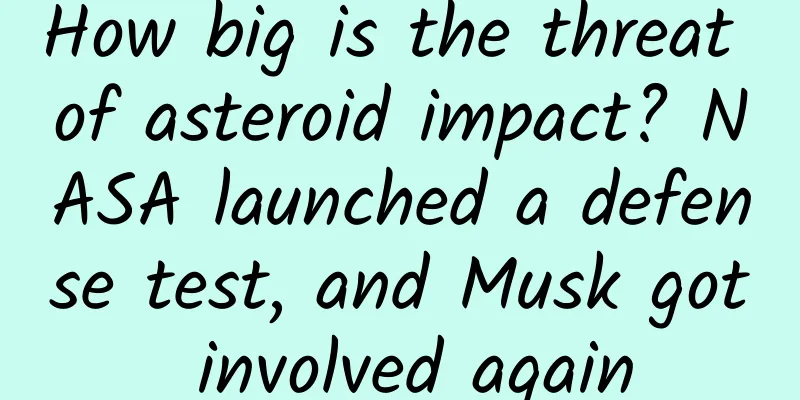How big is the threat of asteroid impact? NASA launched a defense test, and Musk got involved again

|
On November 24, that is, yesterday, a Falcon 9 carrier rocket took off from the launch base, carrying an asteroid redirection probe developed by NASA. This is the first time that humans have said no to an asteroid hitting the earth. This is another new challenge for the tiny human beings and nature. And in this challenge, Musk, an outlier in the human race, intervened again, and his SpaceX rocket company undertook this significant launch mission. Many people are puzzled by scientists' repeated development of space projects, and think that instead of spending money and energy on it, they should transform the earth to make people eat better and live more comfortably. In fact, this is short-sighted, and they have no idea what science is and how their current lives came about. Among them is the lack of understanding of the hazards of asteroid impacts. So how big a threat are asteroid impacts? Some people who have no idea about celestial body impacts think that an asteroid impact is nothing more than a big rock or a big snowball falling down, or a hole in the ground. Even if there is an asteroid as big as Mount Everest, what does it mean compared to the vast earth? If I tell you that a 100-meter asteroid can create a crater several kilometers in diameter, and a 10-kilometer asteroid can create a crater 180 kilometers in diameter, would you still think it doesn't matter? 65 million years ago, an asteroid with a diameter of about 10 kilometers hit the northern part of the Yucatan Peninsula in Mexico, forming an impact crater with a diameter of about 180 kilometers, which led to the final extinction of the dinosaurs that had dominated the world for 160 million years. Some people may still be confused: even if the impact creates a 180-kilometer crater, the Earth has a circumference of 40,000 kilometers and a surface area of 510 million square kilometers. This crater is like a sesame seed on the surface of the Earth, so how can it destroy the entire ant on the basketball? This is because these people do not understand the relationship between speed, mass and energy. The asteroid struck 65 million years ago with an impact energy equivalent to the explosive power of 100 trillion tons of TNT, equivalent to the explosive power of 7.7 billion Hiroshima atomic bombs. Currently, every person in the world can get an atomic bomb. The explosive power of this impact is nearly 10,000 times the total equivalent of the world's existing nuclear warheads. Isn't it scary? Is it still indifferent? Why are asteroid impacts so powerful? A bullet weighs only a few grams, but it can kill a person weighing 100 to 200 kilograms and can punch a big hole in an object because of its high speed. The speed of a bullet is generally several hundred meters per second, which is about the speed of sound. For example, the bullet of a Type 54 pistol weighs about 4.3g (grams) and has a speed of about 430 meters per second; a sniper rifle bullet can't exceed a speed of one thousand meters per second. The conversion formula for impact energy is: E=1/2mv^2. Here E is energy, unit J (joule); m is mass, unit kg (kilogram); v is impact velocity, unit m (meter/second). According to this formula, we can calculate that the impact energy of a Type 54 pistol bullet is about 398J. Of course, this is only the initial velocity of the bullet. As the bullet flies farther, the velocity will decrease due to air resistance and the earth's gravity. The lethal kinetic energy standards for bullets set by some countries are 78J in the United States and Germany, and 98J in China and Russia. How fast is the asteroid's impact speed? The slowest is more than ten kilometers per second, and the fastest is forty or fifty kilometers per second. It is completely not on the same order of magnitude as a bullet, so the impact force is of course much greater. Let's calculate the impact energy of the 10-kilometer-diameter asteroid 65 million years ago at a speed of 20 kilometers per second. Assuming that the asteroid is a perfect sphere with a density similar to that of water, according to the spherical volume calculation formula V=(4/3)πr^3, we can deduce that the volume of the asteroid is about 523.6km^3 (cubic kilometers or cubic kilometers) and the mass is about 5.24*10^14kg (kilograms or kilograms). How big is the impact energy? According to the formula, the impact energy is about 1*10^23J. How big is this energy? The energy released by the explosion of 1 ton of dynamite is 4184000000J. The impact energy of this asteroid is equivalent to the explosion equivalent of 25 trillion tons of dynamite. The actual energy of the asteroid impact 65 million years ago Scientists have estimated the impact energy of the asteroid 65 million years ago to be about 100 trillion tons, which means that in the scientific modeling of the impact energy of the asteroid, scientists used larger data such as speed, density, and volume. As a popular science, of course, we must follow the common sense recognized by the scientific community, so we use the data of 100 trillion tons of impact energy here. Now let's describe the energy of this: Since the invention of the atomic bomb, only two have been used in actual combat, both dropped on Japan, the first on Hiroshima and the second on Nagasaki. The actual explosion equivalent of the atomic bomb dropped on Hiroshima was about 13,000 tons of TNT, resulting in the death of 200,000 people. The energy of the asteroid impact 65 million years ago was equivalent to 7.7 billion times the power of the Hiroshima atomic bomb. In other words, the total population of the world, young and old, is more than 7.6 billion, and each person has a Hiroshima-level atomic bomb. It is often said that the shadow of nuclear war is the biggest threat to mankind. The nuclear weapons that mankind now possesses are enough to destroy mankind several times. So how many nuclear weapons are there in the world now? The annual report data released by the Stockholm International Peace Research Institute in Sweden is considered to be the most authoritative nuclear weapons data recognized by the world. In 2020, the total number of nuclear warheads in the world was 13,400. These nuclear warheads are large and small. Calculated at an average of 1 million tons of equivalent, the total equivalent is only 13.4 billion tons. In other words, the impact energy of the asteroid 65 million years ago is equivalent to 7,463 times the total number of nuclear warheads in the world today. How many times do you think it would take to destroy the earth's ecology? The secondary disasters of asteroid impacts are even worse The disaster caused by an asteroid impact is not just a shock or explosion caused by a single impact, but a long-lasting disaster. The impact will bring about a thousand-meter tsunami and crustal rupture, which will impact and submerge most of the land, trigger global volcanic eruptions, and form global volcanic eruptions for several months (magma splashing everywhere). The magma dust will burst into the sky and block out the sun, causing the earth to lose sunlight for several years or even decades, all plants will die, the food chain will be broken, the ecological chain will be broken, and eventually most of all creatures will become extinct. The Earth needs millions of years to recover before new life can sprout again, which is equivalent to a life restart. Therefore, asteroid impacts are not only the biggest threat to humans, but also a major threat to all ecosystems on Earth. Even a small asteroid impact can cause significant damage to life. For example, the Tunguska explosion more than 100 years ago caused damage to an area of several thousand square kilometers. The result of scientific research is that the asteroid that hit there was only a few dozen meters in size and was most likely a comet. It had already vaporized before it touched the ground, and it was its shock wave that caused the disaster. The asteroid impact that occurred in Chelyabinsk, Russia in 2013 was just an asteroid fragment with a diameter of about 20 meters, which hit us at a speed of 18.9 kilometers per second. The impact energy was about 450,000 tons of TNT equivalent, equivalent to the power of more than 30 Hiroshima atomic bombs. Fortunately, it fell in an open area (a frozen lake far away from the city), but it still caused 7,200 buildings to be damaged and 1,500 people to be injured. International response to the asteroid impact hazard Since asteroids pose such a great threat to humans, responding to asteroid impacts has become a very important task for humans. As early as 2008, the United Nations established a Space Explorers Federation to respond to hazards from space. After the Chelyabinsk meteorite incident in Russia in 2013, the United Nations felt the threat of approaching asteroids and decided to change the development direction of the Space Explorers Federation and established the "International Asteroid Warning Organization" in October. This organization is composed of scientists, observatories and space agencies from all over the world. Its mission is to share information about newly discovered asteroids and how likely they are to hit the Earth. When encountering an asteroid threat, it will work with disaster relief agencies to mobilize global resources to take countermeasures. In addition, a space mission planning advisory organization has been established to study how to deflect the orbits of asteroids that may hit the Earth. After years of research and experiments, scientists believe that the measures to prevent the Earth from being hit by asteroids mainly include kinetic impact, gravitational drag, nuclear bomb explosion, etc. Because asteroids fly very fast, when they are far away, it does not take much force to deviate from their orbit. Kinetic impact is the simplest and most feasible method, so NASA has been preparing for this experiment. Just yesterday, NASA launched a program called the Double Asteroid Redirection Test, or DART mission for short. This is the first time in human history that humans have tested the defense against a possible asteroid impact threat, and it is of great milestone significance to the future survival and reproduction of mankind. The specific process of the DART mission The impact target this time is not an asteroid that is heading towards the earth, but a group of binary asteroids orbiting the sun. The main asteroid is called "Didymos" with a diameter of about 780 meters. There is a satellite next to it, called "Dimorphos", with a diameter of about 160 meters, which orbits Didymos every 11.9 hours. This group of asteroids is in an elliptical orbit around the sun, which takes about 770 days to orbit the sun, which is equivalent to more than two years on Earth. After long-term monitoring, this asteroid will not threaten the Earth in the foreseeable future. The asteroid redirector probe launched by NASA is only to hit the satellite Dimorphos to deviate its orbit, but it will not deviate from the main star, so it will not pose a threat to the Earth. By monitoring the data of this impact, scientists can calculate how much force is needed to shift the asteroid's orbit based on the intensity of the impact, the asteroid's movement speed and the amount of orbital deviation, thereby obtaining valuable empirical data for building models for future response to asteroid impacts. After long-term observation and monitoring of this group of asteroids, they will approach the Earth once every 20 years. The next time they approach will be on October 4, 2022, when they will be about 10.66 million kilometers from the Earth. This is the impact window selected by the DART mission. However, it is not easy to aim at an asteroid in space. It is not as simple as some people imagine that when an asteroid comes, you just need to meet it. It is a long-term process of changing orbits and tracking the approach. Therefore, now is the best launch window. Therefore, this probe with a special mission will drift alone in the vast dark space for nearly a year, and will not reach the designated location until the end of September next year. At this time, the asteroid is close to the Earth and its brightness can reach 14.5, which is the best time for various telescopes, radars, and satellites on Earth to observe and evaluate the impact process and effects. The 550-kilogram probe will crash into Dimorphos at a speed of 6.6 kilometers per second, smashing it into pieces and obtaining a set of valuable data for humans. This is just the beginning. In the next 10 years, NASA and ESA will have many follow-up plans like this. What we can look forward to now is that in October next year, another big drama related to the fate of mankind will begin. I am very grateful that there are such a group of far-sighted people in the human world, including Musk and many scientists. It is their "worrying about the future" spirit and their preparation for a rainy day that make human beings feel more secure. Therefore, I despise those scum who do not respect science and even wantonly denigrate scientists. If there were no civilization brought by science and escorted by it, how could these people live a life of drunkenness and dream without shame? What do you think? Welcome to discuss, thanks for reading. The copyright of Space-Time Communication is original. Infringement and plagiarism are unethical behavior. Please understand and cooperate. |
Recommend
How to operate short videos? Let’s talk about these 4 aspects!
Nowadays, the popularity of Tik Tok has attracted...
Mid-Autumn Festival Marketing: How to Create a “High-Level” Marketing Effect?
In the book “It’s Rare in Life to Be Calm”, Mr. L...
Where do old iPhone parts go? Apple may be using them to build new phones
Figure 1: Daisy, Apple's recycling robot, can...
How can the education industry improve overall customer acquisition results?
China's education industry is entering a gold...
How much does it cost per year to run a personal store on Kuaishou? What does it cost to open a Kuaishou store?
This article mainly introduces how much it costs ...
There are three major dimensions for choosing a bottle for your baby. Many parents make a mistake in the first step!
There are three major dimensions for choosing a b...
Robin Li announced: China's first L4 autonomous driving passenger car is here!
On November 1, the 2018 Baidu World Conference wa...
China's space station was forced to avoid collision twice? Space is vast, but Starlink can't do whatever it wants
★ Although space is vast, the number of usable or...
God Particle: Exploring the Mysterious Origin of Mass
Have you ever wondered why some objects are as he...
Keep brand marketing promotion model!
In recent years, I have found that vertical Inter...
Gou Wenqiang's 31 Posture Correction Training Camp
Gou Wenqiang's 31 Posture Correction Training...
Uber is facing a series of crises, and many employees have lost confidence and are looking for new ways out.
According to the online version of the Financial ...
World Love Beans Day! Beans, how come you are so outstanding?
February 10th is the fifth "World Pulses Day...
In-depth interpretation of "TikTok Enterprise Blue V White Paper": What should TikTok Blue V do?
At the end of June, Douyin released the "Dou...









![[Popular Science of Chinese Military Technology] From "nothing to nothing" to "hitting the target from a hundred steps away", the evolution of tank artillery aiming](/upload/images/67f2310ebede3.webp)